Advanced Information Systems: SF MIS Analysis and Strategies
VerifiedAdded on 2020/12/18
|7
|1411
|199
Report
AI Summary
This report provides a comprehensive analysis of the Management Information System (MIS) implemented by Stately Furniture (SF), a handcrafted furniture producer. The report begins with an introduction to MIS, emphasizing its role in organizational management, evaluation, and decision-making. It then identifies key components within SF's MIS, including strategies for improving communication, inventory management, and customer relations. The analysis highlights the need for SF to adopt technology, such as its own website, local area networks, and a centralized database, to enhance its operations and compete effectively. The report also discusses the implementation of specialized software for inventory and material management, along with the importance of IT expertise. Furthermore, it explores the integration of simulation tools to assist in design and production processes, and details key components of MIS within the context of a furniture enterprise, including manufacturing, marketing, materials management, and financial information systems. The report concludes by emphasizing the importance of MIS in improving SF’s services, products, and overall profitability.
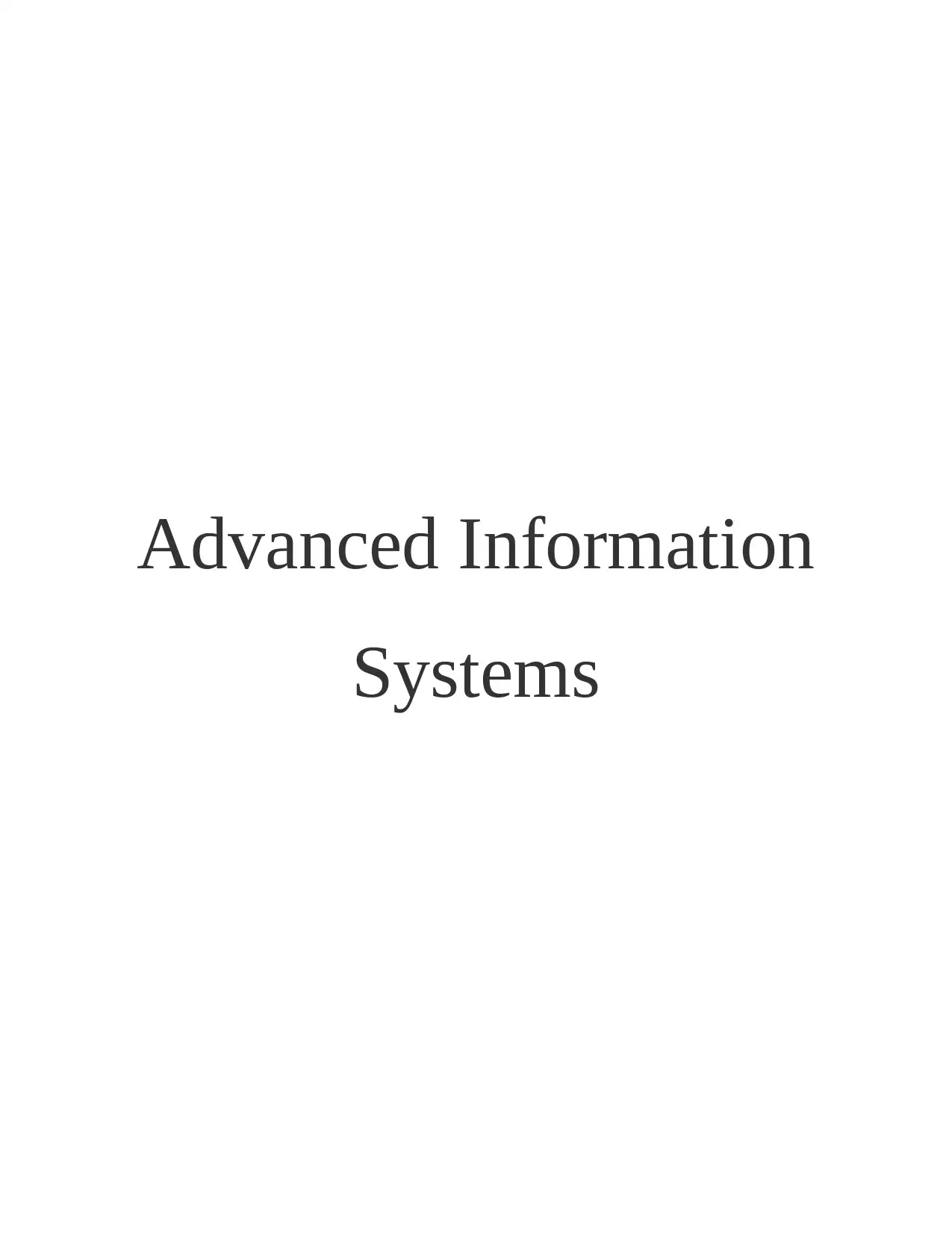
Advanced Information
Systems
Systems
Paraphrase This Document
Need a fresh take? Get an instant paraphrase of this document with our AI Paraphraser
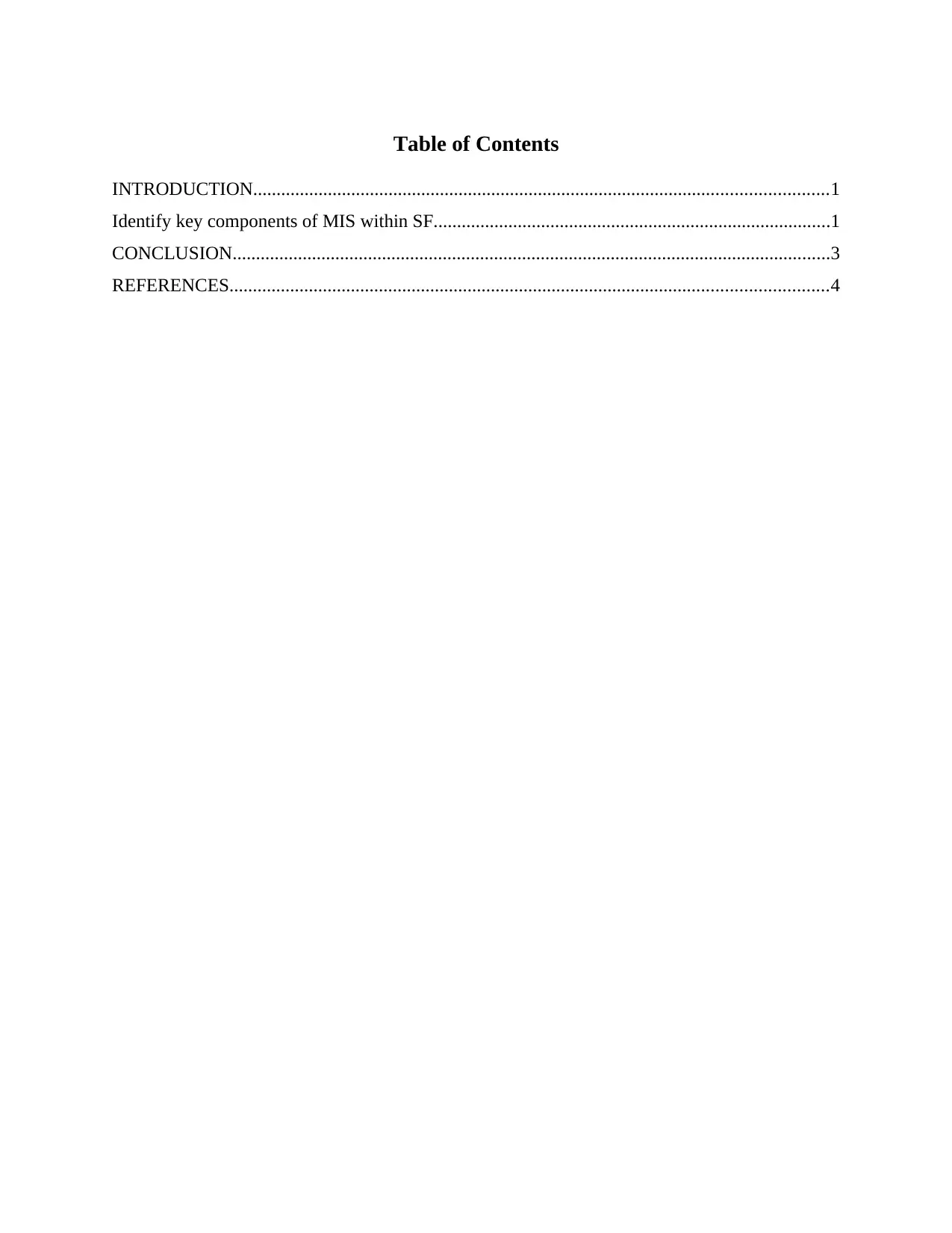
Table of Contents
INTRODUCTION...........................................................................................................................1
Identify key components of MIS within SF.....................................................................................1
CONCLUSION................................................................................................................................3
REFERENCES................................................................................................................................4
INTRODUCTION...........................................................................................................................1
Identify key components of MIS within SF.....................................................................................1
CONCLUSION................................................................................................................................3
REFERENCES................................................................................................................................4
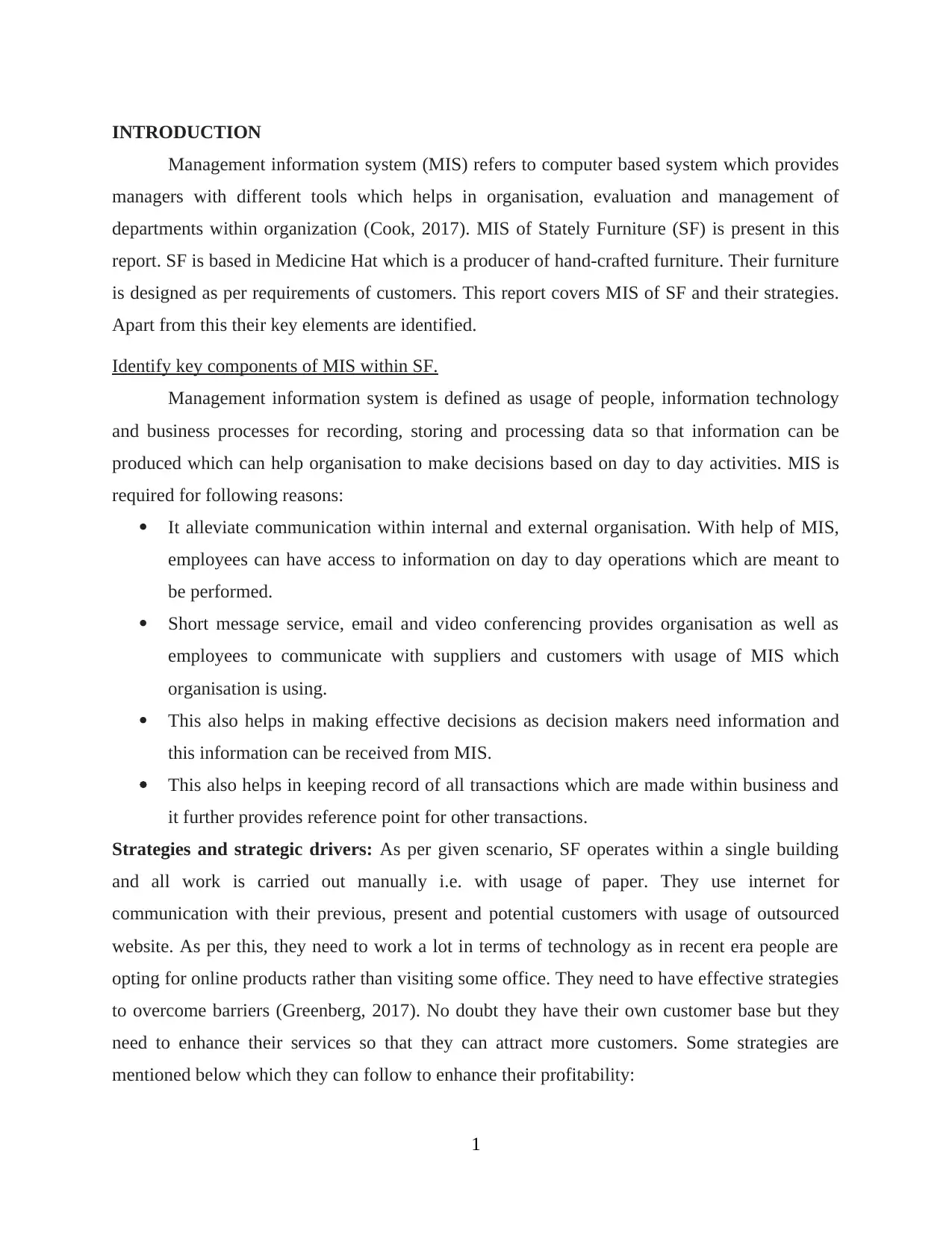
INTRODUCTION
Management information system (MIS) refers to computer based system which provides
managers with different tools which helps in organisation, evaluation and management of
departments within organization (Cook, 2017). MIS of Stately Furniture (SF) is present in this
report. SF is based in Medicine Hat which is a producer of hand-crafted furniture. Their furniture
is designed as per requirements of customers. This report covers MIS of SF and their strategies.
Apart from this their key elements are identified.
Identify key components of MIS within SF.
Management information system is defined as usage of people, information technology
and business processes for recording, storing and processing data so that information can be
produced which can help organisation to make decisions based on day to day activities. MIS is
required for following reasons:
It alleviate communication within internal and external organisation. With help of MIS,
employees can have access to information on day to day operations which are meant to
be performed.
Short message service, email and video conferencing provides organisation as well as
employees to communicate with suppliers and customers with usage of MIS which
organisation is using.
This also helps in making effective decisions as decision makers need information and
this information can be received from MIS.
This also helps in keeping record of all transactions which are made within business and
it further provides reference point for other transactions.
Strategies and strategic drivers: As per given scenario, SF operates within a single building
and all work is carried out manually i.e. with usage of paper. They use internet for
communication with their previous, present and potential customers with usage of outsourced
website. As per this, they need to work a lot in terms of technology as in recent era people are
opting for online products rather than visiting some office. They need to have effective strategies
to overcome barriers (Greenberg, 2017). No doubt they have their own customer base but they
need to enhance their services so that they can attract more customers. Some strategies are
mentioned below which they can follow to enhance their profitability:
1
Management information system (MIS) refers to computer based system which provides
managers with different tools which helps in organisation, evaluation and management of
departments within organization (Cook, 2017). MIS of Stately Furniture (SF) is present in this
report. SF is based in Medicine Hat which is a producer of hand-crafted furniture. Their furniture
is designed as per requirements of customers. This report covers MIS of SF and their strategies.
Apart from this their key elements are identified.
Identify key components of MIS within SF.
Management information system is defined as usage of people, information technology
and business processes for recording, storing and processing data so that information can be
produced which can help organisation to make decisions based on day to day activities. MIS is
required for following reasons:
It alleviate communication within internal and external organisation. With help of MIS,
employees can have access to information on day to day operations which are meant to
be performed.
Short message service, email and video conferencing provides organisation as well as
employees to communicate with suppliers and customers with usage of MIS which
organisation is using.
This also helps in making effective decisions as decision makers need information and
this information can be received from MIS.
This also helps in keeping record of all transactions which are made within business and
it further provides reference point for other transactions.
Strategies and strategic drivers: As per given scenario, SF operates within a single building
and all work is carried out manually i.e. with usage of paper. They use internet for
communication with their previous, present and potential customers with usage of outsourced
website. As per this, they need to work a lot in terms of technology as in recent era people are
opting for online products rather than visiting some office. They need to have effective strategies
to overcome barriers (Greenberg, 2017). No doubt they have their own customer base but they
need to enhance their services so that they can attract more customers. Some strategies are
mentioned below which they can follow to enhance their profitability:
1
⊘ This is a preview!⊘
Do you want full access?
Subscribe today to unlock all pages.

Trusted by 1+ million students worldwide
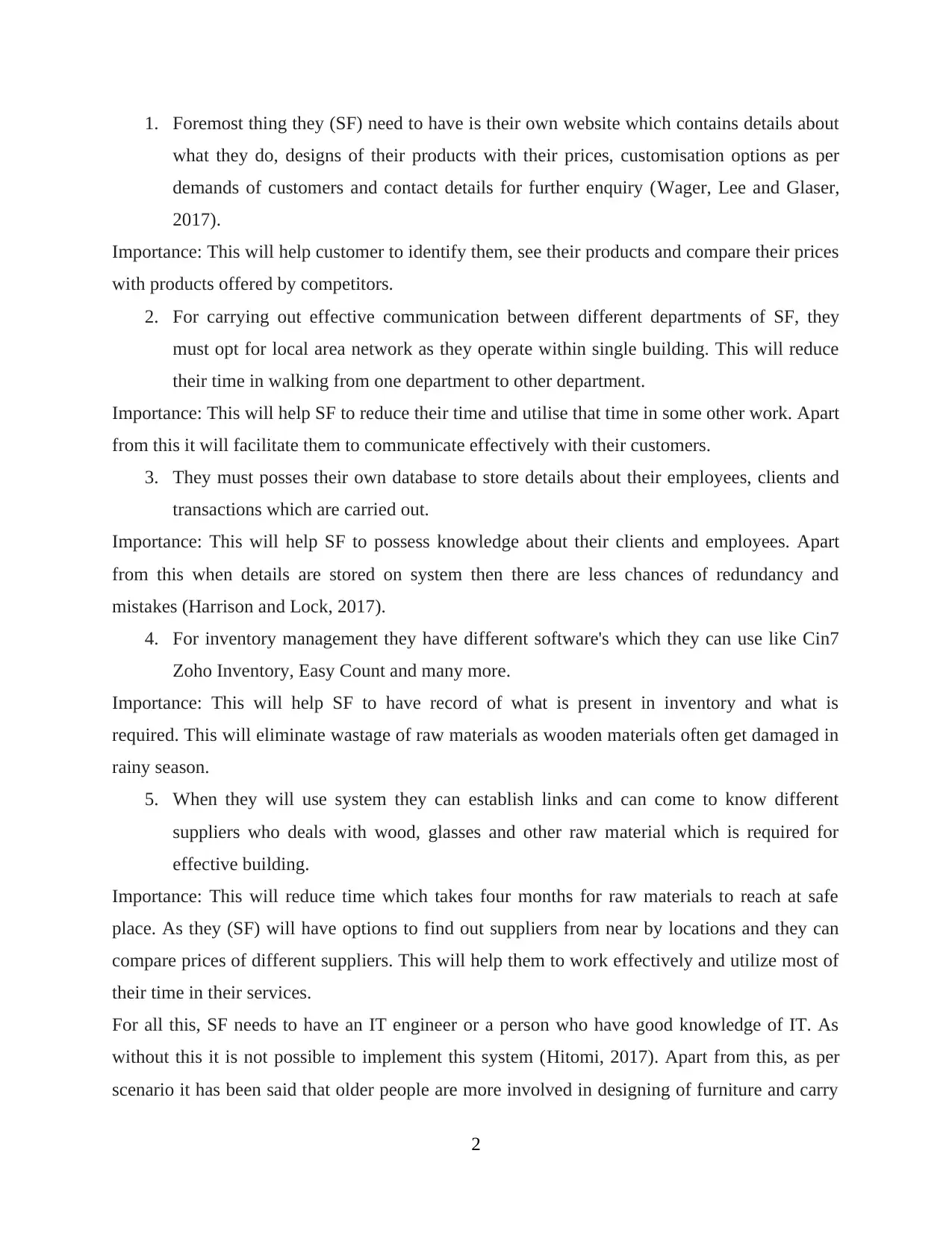
1. Foremost thing they (SF) need to have is their own website which contains details about
what they do, designs of their products with their prices, customisation options as per
demands of customers and contact details for further enquiry (Wager, Lee and Glaser,
2017).
Importance: This will help customer to identify them, see their products and compare their prices
with products offered by competitors.
2. For carrying out effective communication between different departments of SF, they
must opt for local area network as they operate within single building. This will reduce
their time in walking from one department to other department.
Importance: This will help SF to reduce their time and utilise that time in some other work. Apart
from this it will facilitate them to communicate effectively with their customers.
3. They must posses their own database to store details about their employees, clients and
transactions which are carried out.
Importance: This will help SF to possess knowledge about their clients and employees. Apart
from this when details are stored on system then there are less chances of redundancy and
mistakes (Harrison and Lock, 2017).
4. For inventory management they have different software's which they can use like Cin7
Zoho Inventory, Easy Count and many more.
Importance: This will help SF to have record of what is present in inventory and what is
required. This will eliminate wastage of raw materials as wooden materials often get damaged in
rainy season.
5. When they will use system they can establish links and can come to know different
suppliers who deals with wood, glasses and other raw material which is required for
effective building.
Importance: This will reduce time which takes four months for raw materials to reach at safe
place. As they (SF) will have options to find out suppliers from near by locations and they can
compare prices of different suppliers. This will help them to work effectively and utilize most of
their time in their services.
For all this, SF needs to have an IT engineer or a person who have good knowledge of IT. As
without this it is not possible to implement this system (Hitomi, 2017). Apart from this, as per
scenario it has been said that older people are more involved in designing of furniture and carry
2
what they do, designs of their products with their prices, customisation options as per
demands of customers and contact details for further enquiry (Wager, Lee and Glaser,
2017).
Importance: This will help customer to identify them, see their products and compare their prices
with products offered by competitors.
2. For carrying out effective communication between different departments of SF, they
must opt for local area network as they operate within single building. This will reduce
their time in walking from one department to other department.
Importance: This will help SF to reduce their time and utilise that time in some other work. Apart
from this it will facilitate them to communicate effectively with their customers.
3. They must posses their own database to store details about their employees, clients and
transactions which are carried out.
Importance: This will help SF to possess knowledge about their clients and employees. Apart
from this when details are stored on system then there are less chances of redundancy and
mistakes (Harrison and Lock, 2017).
4. For inventory management they have different software's which they can use like Cin7
Zoho Inventory, Easy Count and many more.
Importance: This will help SF to have record of what is present in inventory and what is
required. This will eliminate wastage of raw materials as wooden materials often get damaged in
rainy season.
5. When they will use system they can establish links and can come to know different
suppliers who deals with wood, glasses and other raw material which is required for
effective building.
Importance: This will reduce time which takes four months for raw materials to reach at safe
place. As they (SF) will have options to find out suppliers from near by locations and they can
compare prices of different suppliers. This will help them to work effectively and utilize most of
their time in their services.
For all this, SF needs to have an IT engineer or a person who have good knowledge of IT. As
without this it is not possible to implement this system (Hitomi, 2017). Apart from this, as per
scenario it has been said that older people are more involved in designing of furniture and carry
2
Paraphrase This Document
Need a fresh take? Get an instant paraphrase of this document with our AI Paraphraser
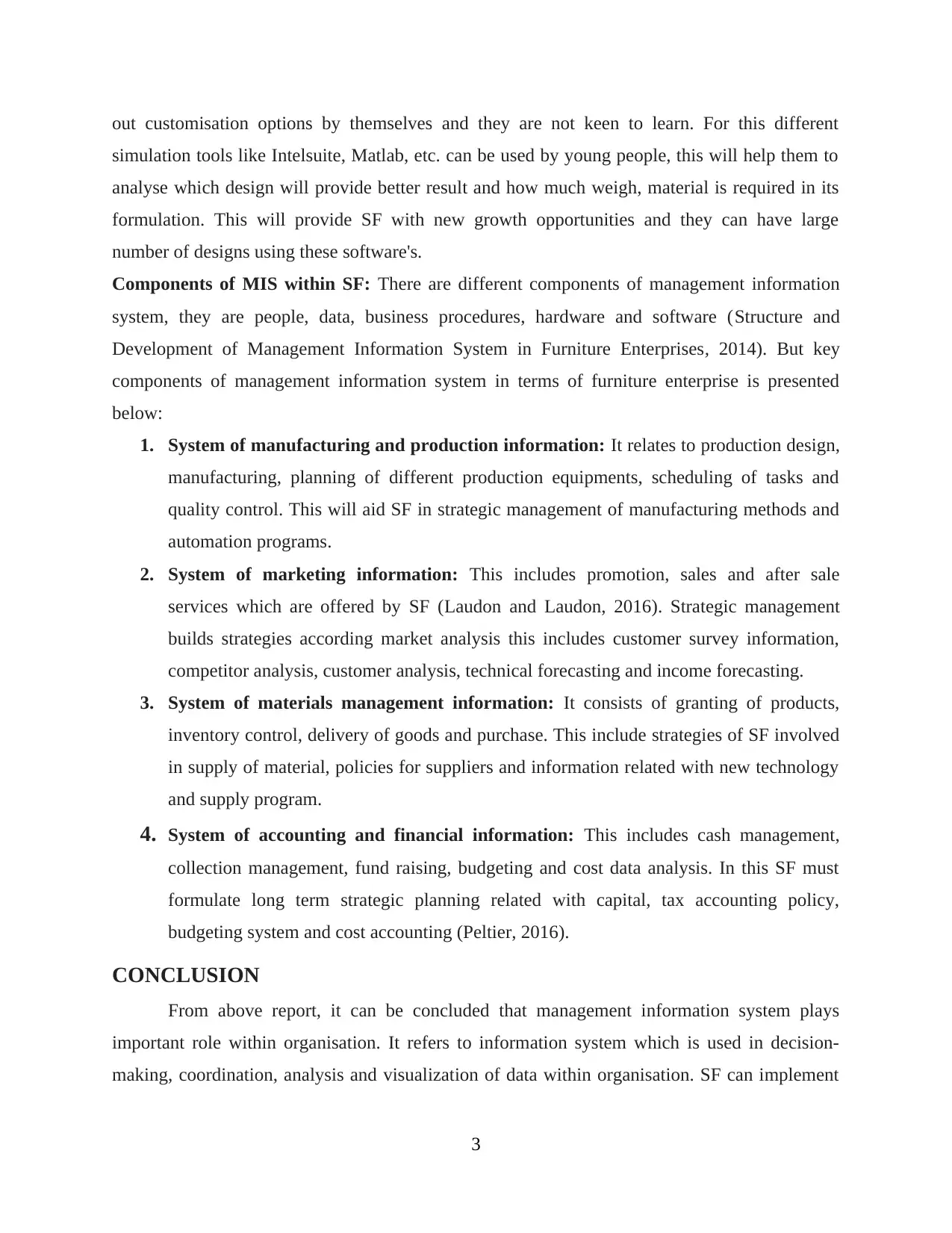
out customisation options by themselves and they are not keen to learn. For this different
simulation tools like Intelsuite, Matlab, etc. can be used by young people, this will help them to
analyse which design will provide better result and how much weigh, material is required in its
formulation. This will provide SF with new growth opportunities and they can have large
number of designs using these software's.
Components of MIS within SF: There are different components of management information
system, they are people, data, business procedures, hardware and software (Structure and
Development of Management Information System in Furniture Enterprises, 2014). But key
components of management information system in terms of furniture enterprise is presented
below:
1. System of manufacturing and production information: It relates to production design,
manufacturing, planning of different production equipments, scheduling of tasks and
quality control. This will aid SF in strategic management of manufacturing methods and
automation programs.
2. System of marketing information: This includes promotion, sales and after sale
services which are offered by SF (Laudon and Laudon, 2016). Strategic management
builds strategies according market analysis this includes customer survey information,
competitor analysis, customer analysis, technical forecasting and income forecasting.
3. System of materials management information: It consists of granting of products,
inventory control, delivery of goods and purchase. This include strategies of SF involved
in supply of material, policies for suppliers and information related with new technology
and supply program.
4. System of accounting and financial information: This includes cash management,
collection management, fund raising, budgeting and cost data analysis. In this SF must
formulate long term strategic planning related with capital, tax accounting policy,
budgeting system and cost accounting (Peltier, 2016).
CONCLUSION
From above report, it can be concluded that management information system plays
important role within organisation. It refers to information system which is used in decision-
making, coordination, analysis and visualization of data within organisation. SF can implement
3
simulation tools like Intelsuite, Matlab, etc. can be used by young people, this will help them to
analyse which design will provide better result and how much weigh, material is required in its
formulation. This will provide SF with new growth opportunities and they can have large
number of designs using these software's.
Components of MIS within SF: There are different components of management information
system, they are people, data, business procedures, hardware and software (Structure and
Development of Management Information System in Furniture Enterprises, 2014). But key
components of management information system in terms of furniture enterprise is presented
below:
1. System of manufacturing and production information: It relates to production design,
manufacturing, planning of different production equipments, scheduling of tasks and
quality control. This will aid SF in strategic management of manufacturing methods and
automation programs.
2. System of marketing information: This includes promotion, sales and after sale
services which are offered by SF (Laudon and Laudon, 2016). Strategic management
builds strategies according market analysis this includes customer survey information,
competitor analysis, customer analysis, technical forecasting and income forecasting.
3. System of materials management information: It consists of granting of products,
inventory control, delivery of goods and purchase. This include strategies of SF involved
in supply of material, policies for suppliers and information related with new technology
and supply program.
4. System of accounting and financial information: This includes cash management,
collection management, fund raising, budgeting and cost data analysis. In this SF must
formulate long term strategic planning related with capital, tax accounting policy,
budgeting system and cost accounting (Peltier, 2016).
CONCLUSION
From above report, it can be concluded that management information system plays
important role within organisation. It refers to information system which is used in decision-
making, coordination, analysis and visualization of data within organisation. SF can implement
3
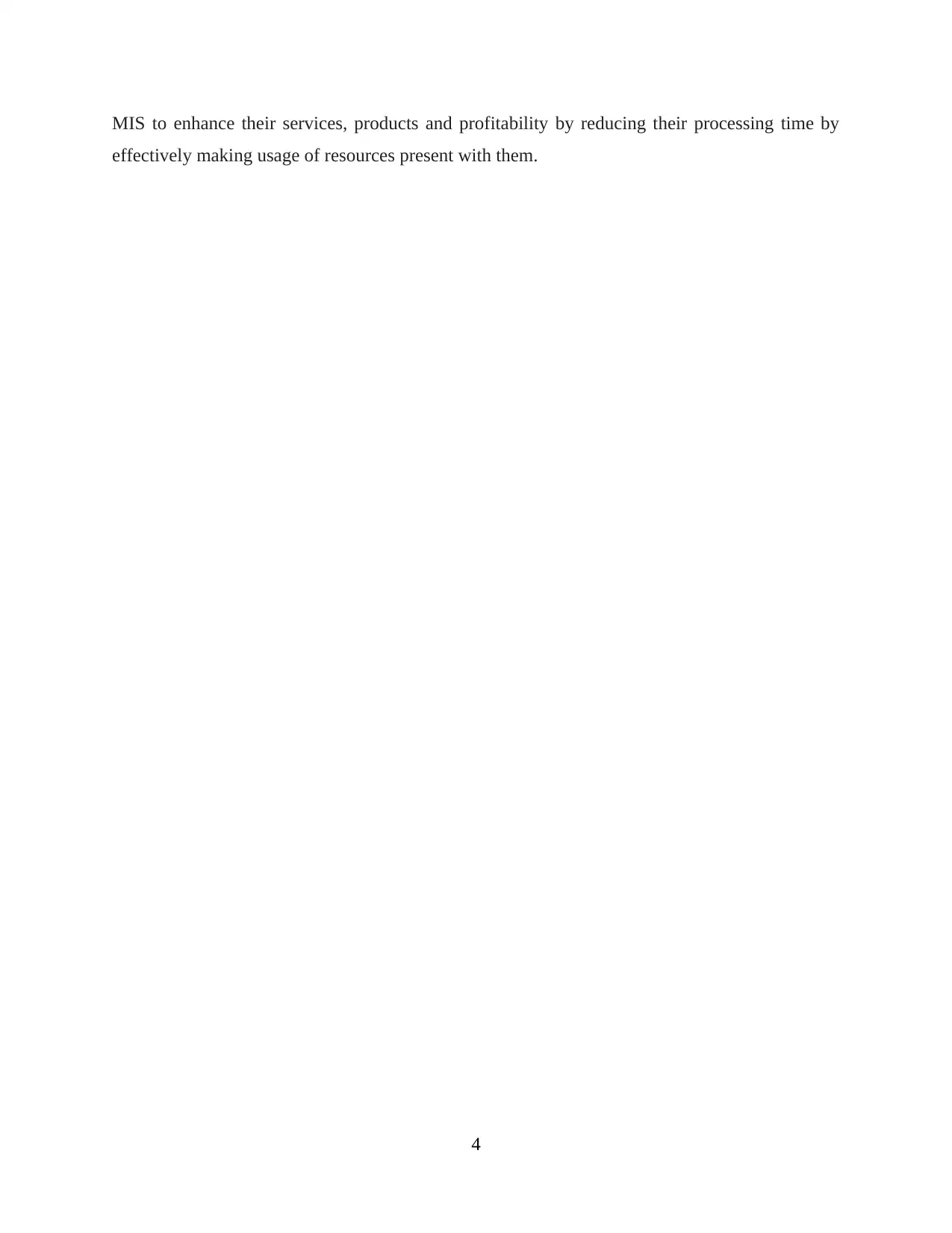
MIS to enhance their services, products and profitability by reducing their processing time by
effectively making usage of resources present with them.
4
effectively making usage of resources present with them.
4
⊘ This is a preview!⊘
Do you want full access?
Subscribe today to unlock all pages.

Trusted by 1+ million students worldwide
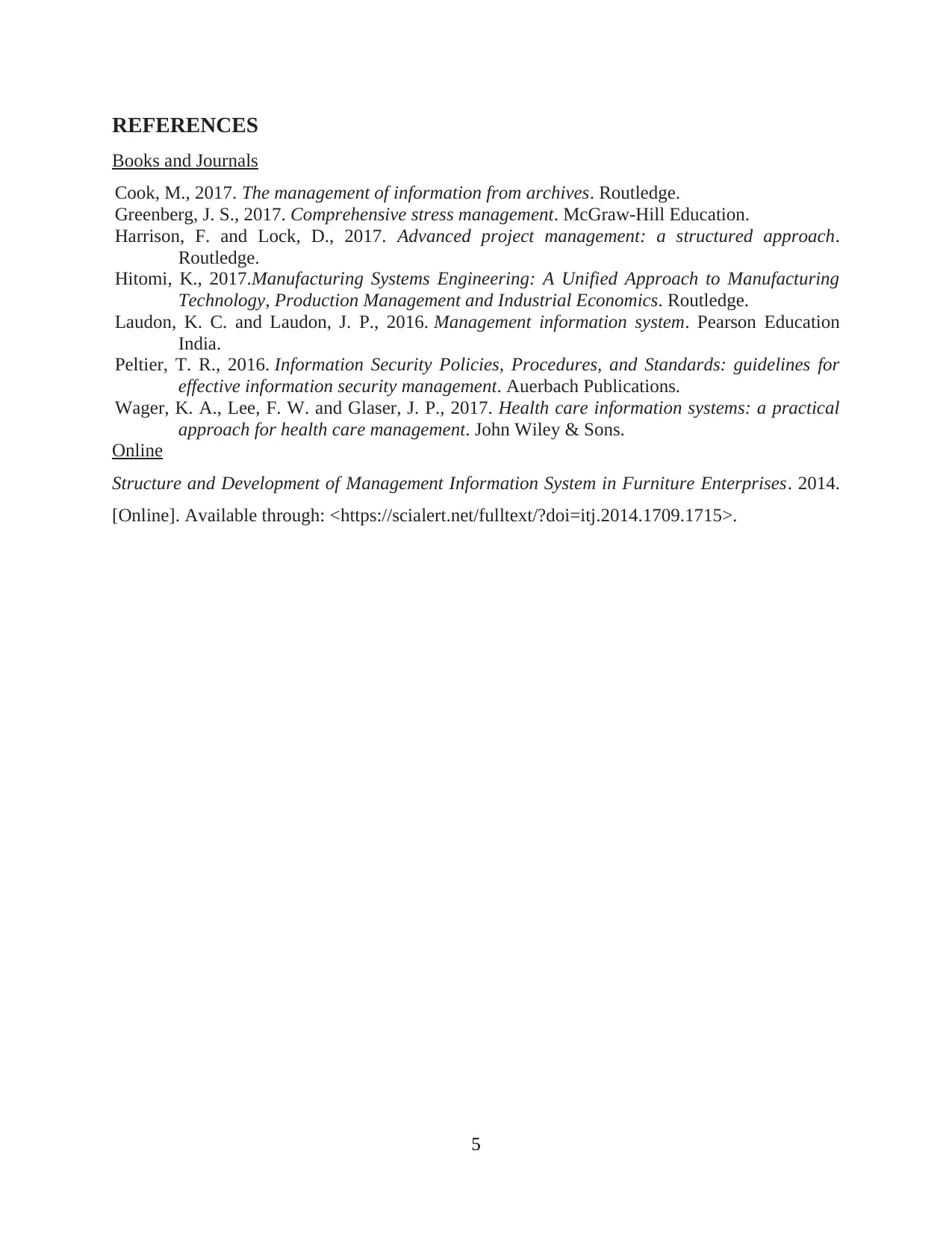
REFERENCES
Books and Journals
Cook, M., 2017. The management of information from archives. Routledge.
Greenberg, J. S., 2017. Comprehensive stress management. McGraw-Hill Education.
Harrison, F. and Lock, D., 2017. Advanced project management: a structured approach.
Routledge.
Hitomi, K., 2017.Manufacturing Systems Engineering: A Unified Approach to Manufacturing
Technology, Production Management and Industrial Economics. Routledge.
Laudon, K. C. and Laudon, J. P., 2016. Management information system. Pearson Education
India.
Peltier, T. R., 2016. Information Security Policies, Procedures, and Standards: guidelines for
effective information security management. Auerbach Publications.
Wager, K. A., Lee, F. W. and Glaser, J. P., 2017. Health care information systems: a practical
approach for health care management. John Wiley & Sons.
Online
Structure and Development of Management Information System in Furniture Enterprises. 2014.
[Online]. Available through: <https://scialert.net/fulltext/?doi=itj.2014.1709.1715>.
5
Books and Journals
Cook, M., 2017. The management of information from archives. Routledge.
Greenberg, J. S., 2017. Comprehensive stress management. McGraw-Hill Education.
Harrison, F. and Lock, D., 2017. Advanced project management: a structured approach.
Routledge.
Hitomi, K., 2017.Manufacturing Systems Engineering: A Unified Approach to Manufacturing
Technology, Production Management and Industrial Economics. Routledge.
Laudon, K. C. and Laudon, J. P., 2016. Management information system. Pearson Education
India.
Peltier, T. R., 2016. Information Security Policies, Procedures, and Standards: guidelines for
effective information security management. Auerbach Publications.
Wager, K. A., Lee, F. W. and Glaser, J. P., 2017. Health care information systems: a practical
approach for health care management. John Wiley & Sons.
Online
Structure and Development of Management Information System in Furniture Enterprises. 2014.
[Online]. Available through: <https://scialert.net/fulltext/?doi=itj.2014.1709.1715>.
5
1 out of 7
Related Documents
Your All-in-One AI-Powered Toolkit for Academic Success.
+13062052269
info@desklib.com
Available 24*7 on WhatsApp / Email
![[object Object]](/_next/static/media/star-bottom.7253800d.svg)
Unlock your academic potential
Copyright © 2020–2025 A2Z Services. All Rights Reserved. Developed and managed by ZUCOL.





